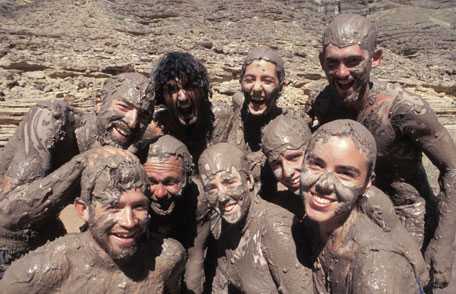Adventure Races

You signed up for an adventure race! You spent months training, getting ready for the tough event. The big day arrives – you go over high walls, wade through mud pits, and maybe even jump over fire. You finally cross the finish line! But a couple of days later, you start to feel sick. You have a fever, diarrhea, nausea, and abdominal cramps.
What do you think made you sick?
High-intensity obstacle and adventure races are becoming more popular every year. In 2012, these races drew an estimated 1.5 million people in the United States alone. These races typically include man-made obstacles for participants to cross, including muddy pits and fields, while running various distances. These races are commonly held in rural areas. If these areas were used for animal grazing, the soil could be contaminated with germs (bacteria, viruses) like E. coli, norovirus, and Campylobacter from the animal feces (poop). And, somehow, those germs can get into people’s mouths. This nasty scenario unfortunately became a reality for some people in Nevada after a long-distance obstacle adventure race held on a cattle ranch in 2012.
After the race, more than 20 participants got sick with diarrhea, vomiting, abdominal cramps, and fever. The cause of their illness was Campylobacter. An epidemiologic study comparing race participants who got sick to race participants who didn’t get sick found that swallowing muddy water while competing was a major risk factor. All of the race participants made a full recovery, but this event is an important reminder of the risk of serious diarrheal illness after adventure races.

Dodge the germs during your adventure race.
What can adventure race participants do to play it safe?
- Avoid swallowing any surface water during the race. The water doesn’t have to be muddy to make you sick.
- Wash your hands and face with soap and water immediately after completing the race, especially before eating or drinking.
- Be considerate to other racers: Stay out of the race if you are vomiting or have diarrhea on race day.
What can organizers of adventure races do to protect racers?
- Build muddy challenges in areas where there is not likely to be animal feces.
- In your information for participants, include advice on how they can protect themselves and others from diarrheal illness:
- Advise them to avoid swallowing any surface water during the race.
- Encourage race participants to seek medical care if they develop diarrhea after the race.
- Ask them to not participate in the event if they are vomiting or have diarrhea on race day.
- Provide facilities for participants to wash their hands and face after the race.
- Page last reviewed: May 23, 2016
- Page last updated: May 23, 2016
- Content source:
- National Center for Emerging and Zoonotic Infectious Diseases
- Page maintained by: Office of the Associate Director for Communication, Digital Media Branch, Division of Public Affairs




 ShareCompartir
ShareCompartir